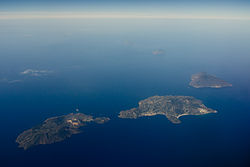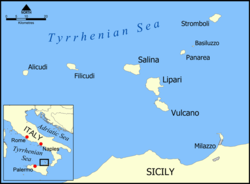Aeolian Islands
Native name: Isole Eolie, Ìsuli Eoli | |
|---|---|
 Aerial view of the Aeolian Islands | |
 Map of the Aeolian Islands | |
| Geography | |
| Location | Tyrrhenian Sea |
| Coordinates | 38°32′N 14°54′E / 38.533°N 14.900°E |
| Area | 114.7 km2 (44.3 sq mi) |
| Administration | |
Italy | |
| Region | Sicily |
| Metropolitan City | Messina |
| Demographics | |
| Population | 15,419 (1 January 2019) |
| Pop. density | 134.4/km2 (348.1/sq mi) |
| Official name | Isole Eolie (Aeolian Islands) |
| Criteria | Natural: viii |
| Reference | 908 |
| Inscription | 2000 (24th Session) |
| Area | 1,216 ha |
The Aeolian Islands (/iːˈoʊliən/ ee-OH-lee-ən; Italian: Isole Eolie [ˈiːsole eˈɔːlje]; Sicilian: Ìsuli Eoli), sometimes referred to as the Lipari Islands or Lipari group (/ˈlɪpəri/ LIP-ə-ree, Italian: [ˈliːpari]) after their largest island, are a volcanic archipelago in the Tyrrhenian Sea north of Sicily, said to be named after Aeolus, the mythical ruler of the winds.[1] The islands' inhabitants are known as Aeolians (Italian: Eoliani). The islands had a permanent population of 14,224 at the 2011 census; the latest official estimate is 15,419 as of 1 January 2019. The Aeolian Islands are a popular tourist destination in the summer and attract up to 600,000 visitors annually.
There are seven significant islands:
, and a set of minor islands and rocks.Geography
The Aeolian Islands are 30 to 80 kilometres (19 to 50 mi) off the north coast of Sicily in the Tyrrhenian Sea. Vulcano is located closest to the Sicilian coast. Lipari and Salina follow to the north, Filicudi and Alicudi to the west, and Panarea and Stromboli to the northeast. In addition to these seven inhabited islands, there are a number of smaller, uninhabited islands and rocky cliffs, such as Basiluzzo, Strombolicchio, Dattilo and Lisca Bianca.
The largest island is Lipari (37.5 km2 [14.5 sq mi]), followed by Salina (26.8 km2 [10.3 sq mi]), Vulcano (21.2 km2 [8.2 sq mi]), Stromboli (12.6 km2 [4.9 sq mi]), Filicudi (9.5 km2 [3.7 sq mi]) and Alicudi (5.2 km2 [2.0 sq mi]). The smallest island, at 3.4 km2 (1.3 sq mi), is Panarea. The highest elevation of the Lipari Islands is Monte Fossa delle Felci on Salina, which reaches a height of 962 m (3,156 ft).[2]
Geology

The seven Aeolian Islands, covering an area of 1,600 km2 (620 sq mi), originated in the Tyrrhenian Basin, a great plain at the bottom of the Tyrrhenian Sea. Emissions of lava from depths of up to 3,600 m (11,800 ft) resulted in the formation of the Aeolian Islands, together with Ustica and a series of submarine volcanoes named Magnani, Vavilov, Marsili and Palinuro, as well as two that are unnamed.
The present shape of the Aeolian Islands is the result of
Geologically the
Administration
The islands form part of the Sicilian Metropolitan City of Messina. All the islands except Salina comprise the comune of Lipari within that province; Salina forms three separate comunes: Malfa, Leni and Santa Marina Salina.
| Commune | Population |
|---|---|
| Leni | 708 |
| Lipari | 11,549 |
| Malfa | 1,001 |
| Santa Marina Salina | 894 |
Architectural control

Curbing
Mythology
In
The hero of the epic poem, Odysseus, on his travels to return home from Troy, visited Aiolos' isle and was entrusted with a bag containing all of the winds to ensure a safe voyage home. However, during the trip, the hero's companions opened the bag and the escaping winds carried their ship all the way back to Aiolos' shore.[8]
History

4000–2500 BC
The first evidence of Sicilian migration was in Lipari (Castellaro Vecchio culture).[9] The manufacture and commerce of obsidian objects was highly developed until the introduction of metals.[10]
1600–1250 BC
During the
1240–850 BC
According to
.600–300 BC
In 580 BC, Greeks exiled from Rhodes and Knidos landed at Lipari and began a period of Greek domination, which was known for acts of piracy against Etruscan and Phoenician shipping. There was production of vases and other ceramics.[13]
300 BC–AD 250

The islanders were allies of the Carthaginians against Rome during the Punic Wars. Although the Battle of the Lipari Islands in 260 BC led to a Carthaginian victory, the Romans later sacked Lipari and their domination led to a period of poverty.[14]
AD 250–1000
At the
1000–1600
The

On June 30, 1544, a fleet of 180
1600–present
In 1693, an
Towards the end of the 19th century, the Aeolian Islands were visited by Archduke Ludwig Salvator of Austria—a friend of the islands and also a man with a profound knowledge of the archipelago. Between the years 1893–96 he published a work of eight volumes on the Aeolian Islands.[18]
In August 1888, the crater named Fossa on Vulcano erupted and caused many deaths in the
On New Year's Day in 1909, a rumour appeared in international newspapers that the Aeolian Islands had been "swallowed up by the sea" during a time of volcanic activity.[19] While communication with the islands was interrupted for a time,[20] they were not otherwise inconvenienced.
During
UNESCO World Heritage Sites
The Aeolian Islands were listed by UNESCO in 2000 as a World Heritage Site for providing "an outstanding record of volcanic island-building and destruction, and ongoing volcanic phenomena".[25] Status as a World Heritage Site was threatened by Italy's failure to close the pumice quarry as well as its failure to prevent the building of 4 new harbours.[26] However, as of 2020[update], it is still listed by UNESCO as a World Heritage site.[27]
See also
References
- ISBN 1-57607-094-8.
- ^ Eolian Islands, in: Earth's Landscape: An Encyclopedia of the World's Geographic Features, 2015, ASIN B00SC8OO9U
- ^ "The Aeolians: The Volcanic Islands". Archived from the original on 2017-07-31. Retrieved 2013-08-03.
- ^ Gasson, John (19 October 2016). "Falling in Love With Italy's Blissful, Rustic Aeolian Islands". The New York Times. Retrieved 4 January 2017.
- ^ "The Aeolian archipelago".
- ISBN 978-1-84353-060-2.
- ^ Sources about Aiolos Retrieved 25 March 2022.
- ^ Homer, Odyssey 10.1–12
 This article incorporates text from this source, which is in the public domain.
This article incorporates text from this source, which is in the public domain.
- ^ Luigi Bernabò Brea, Madeleine Cavalier (Eds.). (1980). Meligunìs Lipára IV. L’acropoli di Lipari nella preistoria. Palermo: Flaccovio.
- ^ Martinelli, Maria & Vianello, Andrea. (2019). Lipari (Aeolian Islands) Obsidian in the Late Neolithic. Artifacts, Supply and Function. Open Archaeology. 5. 46-64. 10.1515/opar-2019-0005.
- ^ Sicily Before the Greeks. The Interaction with Aegean and the Levant in the Pre-colonial Era Retrieved 25 March 2022.
- ^ Bibliotheca historica, book V.
- ^ Brief history of the Aeolian Islands Retrieved 25 March 2022.
- ISBN 978-0-304-36642-2.
- ISBN 978-0-7864-1472-7.
- ^ Joe Russo (October 1, 2015). "Estimating the population of Lipari in 1544". Aeolian Genealogy. Retrieved 18 November 2017.
- Viceroy of Sicilyat the time reported "...and about sixty thousand people died under the ruins of the earthquake" (August 4, 1695)
- ^ Rando, Gaetano. "Filicudi in the Late 19th Century a Scientific Description". Excerpts from die Liparischen Inseln.
- ^ "Médaille d'argent du CNRS à Madeleine Cavalier - Centre Jean Bérard". centrejeanberard.cnrs.fr. Retrieved 2024-03-03.
- ^ Pracanica, Alessio (2020-06-22). "Il museo Bernabò Brea di Lipari, uno dei più ricchi e meno conosciuti musei del Mediterraneo. Foto". Dazebaonews (in Italian). Retrieved 2024-03-03.
- ^ Martinelli, Maria Clara; Spigo, Umberto (2014). "Le isole Eolie dalla fondazione del Museo Archeologico Luigi Bernabò Brea alla istituzione del Parco Archeologico delle Isole Eolie: problemi di tutela e valorizzazione". 150 anni di preistoria e protostoria in Italia. - ( Studi di preistoria e protostoria; 1) (in Italian): 561–565.
- ^ "World Heritage Committee Inscribes 61 New Sites on World Heritage List". UNESCO World Heritage Centre. Retrieved 7 January 2017.
- ^ Eddyburg.it – Le Eolie fuori dai siti Unesco Archived September 27, 2007, at the Wayback Machine
- ^ "Isole Eolie (Aeolian Islands): Indicators. UNESCO".
Further reading
- Ward, Phillip (1974). The Aeolian Islands. The Oleander Press. ISBN 0902675435
- Berlinghieri, Castagnino E.F. (with introduction by A. J. Parker) (2003) The Aeolian Islands: crossroads of Mediterranean maritime routes. A survey on their maritime archaeology and topography from the Prehistoric to the Roman periods, British Archaeological Reports, International Series 1181, Oxford.
External links
 Aeolian Islands travel guide from Wikivoyage
Aeolian Islands travel guide from Wikivoyage- UNESCO World Heritage Sites, Aeolian Islands








